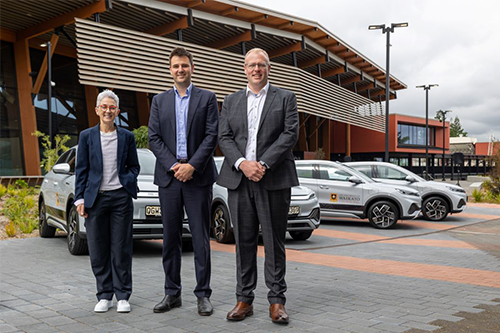Sign up for daily news updates from CleanTechnica on email. Or follow us on Google News!
The University of Waikato in New Zealand has started the journey to transition its fleet to electric. The university is working with several key partners, including Carbn Asset Management, which completed a fleet utilization and optimization study, and the charging station installer We.EV (owned by WEL Networks). We.EV conducted electrical studies on the university’s campus to understand the capacity of the network on site.
Jim Mercer, Chief Operating Officer at the University of Waikato, said sustainability had been a focus for the university over the last 18 months and that moving to EVs was a natural next step. The university will have nearly 80 EVs available to employees once this program is completed. The university is also installing EV charging stations at the Hamilton and Tauranga campuses. The university says this fleet upgrade has been supported with just over $2 million in operational co-funding from EECA (the Energy Efficiency and Conservation Authority), which the university has matched.

In the long run, the university says it hopes to the make EVs and charging stations available to staff outside of hours. The university says this approach will go a long way on the quest to reduce indirect Scope 3 emissions, which are typically challenging to target.
The university and partners have selected the BYD Atto 3 as the make and model for the fleet. The university adds that implementation of the program is being managed by Zilch car-sharing, whose innovative approach will make it easier for staff to access vehicles with features like keyless access.
“This is a great example of using technology to support a sustainable future while also making things easier for employees, saving them from having to collect and return keys physically,” said Mr Mercer.
“We’ve been working on a range of sustainability initiatives, including the launch of the world’s first Bachelor of Climate Change, replacing two natural gas boilers with low-emission alternatives, a sizeable on-campus project to replace existing lighting with sustainable LEDs, installing solar arrays on a number of buildings, and various research initiatives designed to support a sustainable future for New Zealand and the world.”
Paul Bull, EECA Public Sector Portfolio Manager, said the University of Waikato is setting a great example for other tertiary institutions and government organizations.
Mr. Bull added, “The team is demonstrating how you can incorporate EVs into a fleet while also finding other, innovative ways to get the most out of their vehicles.”
Mr. Mercer said, “This is just phase one. We will continue to make upgrades over the coming years to ensure the University of Waikato continues to take steps towards becoming more sustainable.”
This news from the University of Waikato reminded me of my days at university in Pretoria, South Africa, about 10 years ago. The university had quite a large fleet of vehicles that were made available to staff and students for use on various university business trips. For me, one of the most common trips was between the various campuses of my university and also to carry out some experiments at other universities where we had some collaborations.
For example, we would go to Johannesburg to carry out experiments using some equipment that we did not have in our own facility. Professors and students from other universities would also come to our campus to make use of some equipment that they did not have at their universities. One of the most common trips for me was to Wits University to do some Deep Ultra-Violet Raman Spectroscopy, or Heavy Ion-Beam Analysis. The trip was a 120km round-trip from Hatfield, Pretoria, to Wits in Johannesburg. Some of these experiments would go on for 6 hours or so. We used some small ICE cars such as a Ford Focus and a Ford Fiesta. Larger ICE vehicles similar in size to the BYD Atto 3 were also available, depending on the number of passengers. These kinds of applications are therefore perfect for electrification.
A lot of EV models on the market today have a driving range of at least 300 km, so one could use them quite comfortably for these applications. And of course, given the fact that the experiments would run for about 6 hours or so, the EV could be charging on a Level 2 type charger in that time. It just goes to show that universities and similar operations are perfect candidates for electrification.
Image courtesy of University of Waikato
Have a tip for CleanTechnica? Want to advertise? Want to suggest a guest for our CleanTech Talk podcast? Contact us here.
Our Latest EVObsession Video
I don’t like paywalls. You don’t like paywalls. Who likes paywalls? Here at CleanTechnica, we implemented a limited paywall for a while, but it always felt wrong — and it was always tough to decide what we should put behind there. In theory, your most exclusive and best content goes behind a paywall. But then fewer people read it!! So, we’ve decided to completely nix paywalls here at CleanTechnica. But…
Thank you!
CleanTechnica uses affiliate links. See our policy here.




